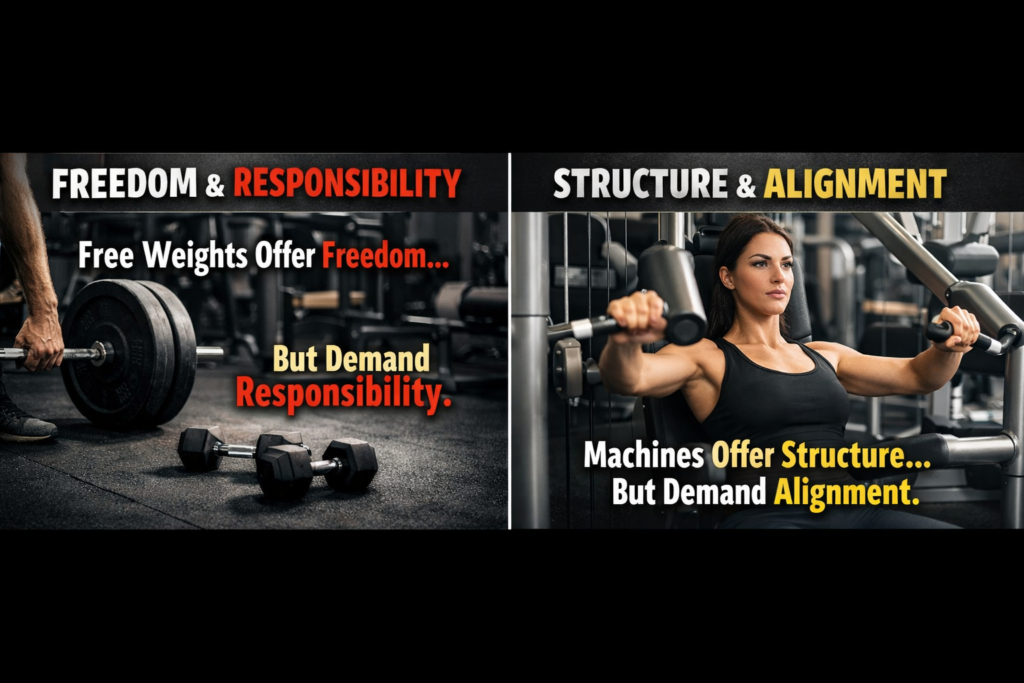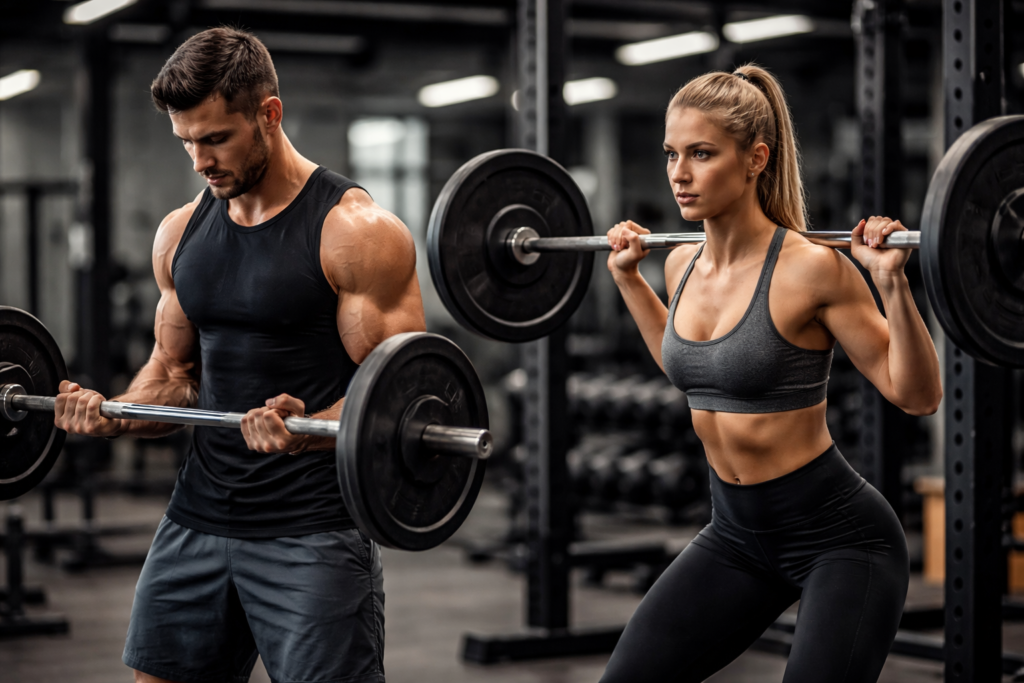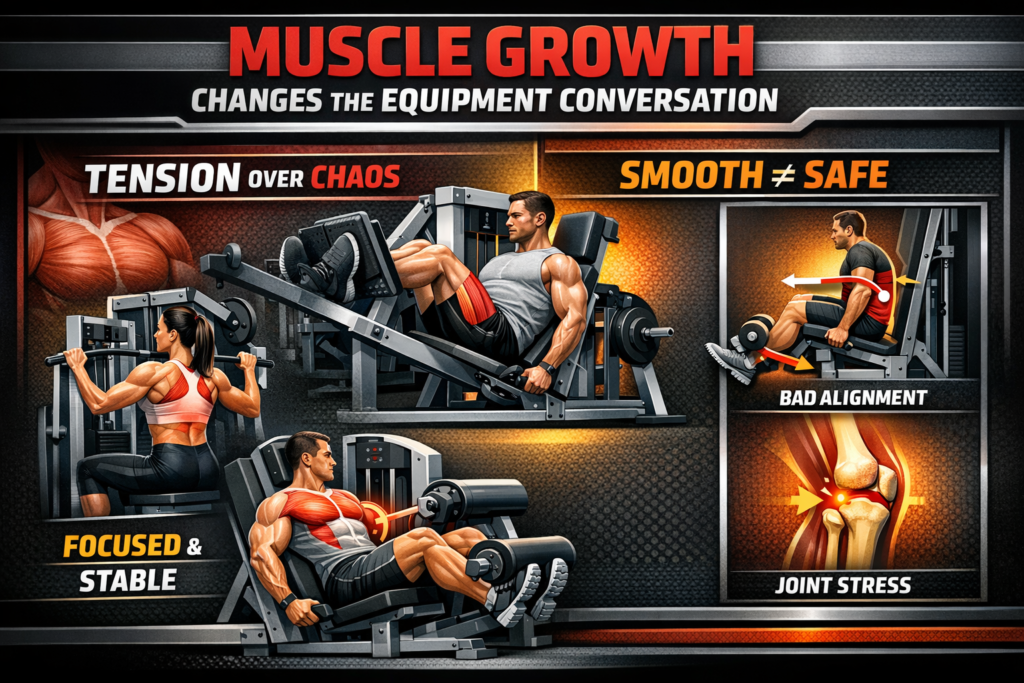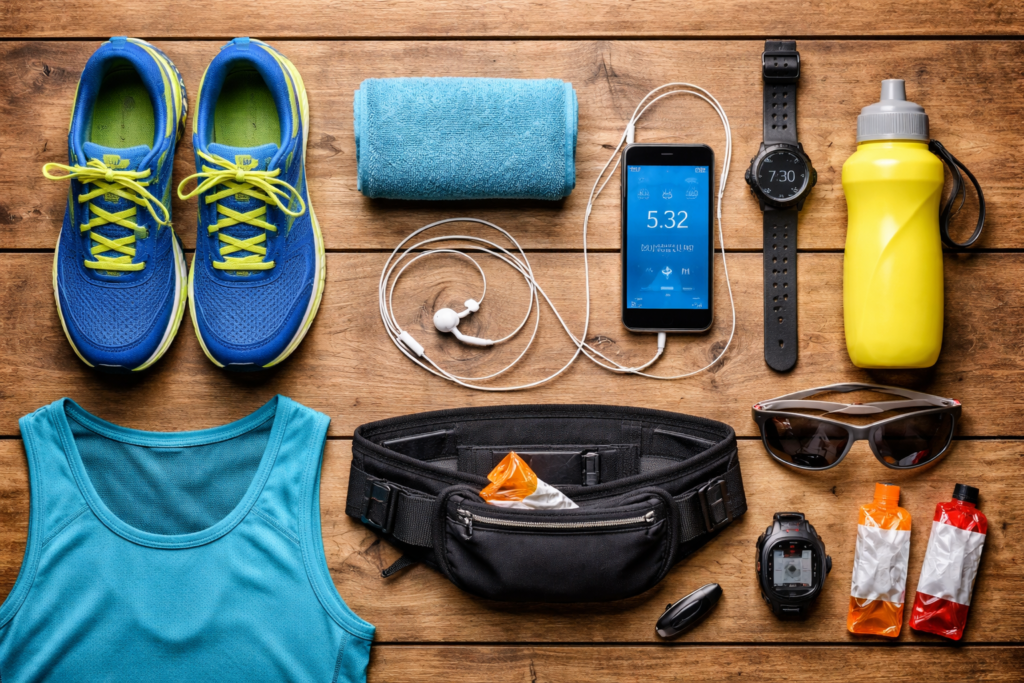Many assume training begins with the workout itself.
A countdown on a screen creates a false sense of starting.
Loaded plates moving through space feel like the first real action.
A belt-powered machine pulling forward seems to mark the beginning.
In reality, training starts much earlier, long before the first repetition or the first step.
It starts with decisions that feel boring, automatic, and almost irrelevant.
What shoes you put on.
What clothes you wear.
What equipment you gravitate toward.
What you carry with you into the gym, and what you leave at home.
These choices don’t feel like “training decisions,” which is exactly why they shape results so deeply over time.
| What This Guide Is (and What It Is Not) |
|---|
| This guide is not here to tell you what to buy.
It is not here to rank products. It is not here to promise shortcuts. It exists to explain how tools shape adaptation. To help you recognize when equipment supports your goals. And when it quietly works against them. Understanding this system does not make training complicated. It makes it sustainable. |
The Illusion of Neutral Equipment

A commercial gym feels like a neutral environment.
Bars are just bars.
Machines are just machines.
Shoes are just shoes.
Clothes are just clothes.
This illusion is comforting, because it removes responsibility from the user.
If equipment is neutral, then pain must come from weakness, bad genetics, or simply “getting older.”
The uncomfortable truth is that equipment is never neutral.
Every object that touches your body or constrains your movement acts as a filter between you and the stress of training.
That filter can distribute stress intelligently.
Or it can concentrate it in the same places, over and over again.
Why the Body Adapts to Tools Faster Than to Programs

Training programs live on paper or screens.
Equipment lives in physical contact with your body.
Your nervous system adapts much faster to physical constraints than to abstract plans.
This is why two people can follow the same program, train with similar effort, and still end up with completely different outcomes.
One adapts smoothly.
The other slowly accumulates irritation without understanding why.
The difference is often not discipline.
It is interaction with the environment.
The body learns how to move based on what it is allowed to do, not on what the program intended.
Repetition Is the Real Driver of Adaptation
Most people associate injury risk with heavy days.
Max attempts.
All-out efforts.
Bad reps.
In reality, most issues come from repetition, not intensity.
The same bench height.
The same bar path.
The same machine setup.
The same shoe cushioning.
The same fabric rubbing in the same places.
None of this hurts immediately.
That is why it is ignored.
The body compensates brilliantly, until compensation becomes fatigue, and fatigue becomes irritation.
Why “Comfortable” Is Not Always Safe

Comfort is a tricky signal.
Something can feel comfortable because it supports your structure.
Or it can feel comfortable because it reduces awareness.
Highly cushioned shoes can feel amazing while increasing instability.
Machines with fixed paths can feel smooth while forcing joints into subtle misalignment.
Thick gloves can feel protective while reducing feedback from the bar.
Comfort in the short term does not guarantee safety in the long term.
Understanding why something feels comfortable matters more than the feeling itself.
The Gym Floor Is Not a Playground

A gym looks like freedom.
In reality, it is a collection of predefined movement options.
Every rack, bench, machine, and cable station offers you a specific solution to a specific problem.
Free weights offer freedom but demand responsibility.
Machines offer structure but demand alignment.
Racks promise safety but only if they are set correctly.
Benches promise stability but only if they actually provide it.
Most problems arise when people assume these tools are interchangeable.
They are not.
Why Most People Start From the Wrong Question
The most common question in gyms is not a good one.
“What should I use for this?”
This question assumes that equipment selection is the starting point.
A better question is harder and less intuitive.
“What am I trying to ask my body to adapt to?”
Once that is clear, equipment selection becomes simpler, not more complicated.
Tools should serve the adaptation, not dictate it.
Strength Training: Where Predictability Matters

When strength is the primary goal, the body craves predictability.
Strength is built by applying force in the same way repeatedly, with gradually increasing demand.
This is why stable bars, solid racks, and benches that do not shift matter so much.
Consistency allows the nervous system to refine coordination instead of constantly recalibrating.
Randomness does not build strength.
It builds noise.
Stability supports progress when it matches your structure.
It becomes a problem when it restricts it.
When Stability Turns Into Restriction

Not all stable setups are supportive.
Some are simply rigid.
A fixed bar path that does not match your joint structure does not feel dangerous at first.
It feels controlled.
That control is seductive, especially when fatigue is high.
Over time, however, restriction replaces guidance, and stress accumulates in the same tissues repeatedly.
This is how equipment quietly works against the body while appearing helpful.
Muscle Growth Changes the Equipment Conversation
 Hypertrophy does not reward chaos.
Hypertrophy does not reward chaos.
It rewards tension.
Machines, cables, and plate-loaded systems become valuable because they reduce unnecessary variables.
They allow muscles to work while stabilizing structures stay relatively calm.
This is not laziness.
It is specificity.
The mistake is assuming that because a machine feels smooth, it is automatically safe.
Smoothness can hide poor alignment just as effectively as it can protect joints.
Longevity Training Requires a Different Mindset
Not everyone trains to push limits forever.
Many people train to keep moving, feeling capable, and avoiding pain.
Here, adjustability becomes more important than load.
Tools that allow small changes in angle and resistance curve support long-term adaptation.
This includes:
- cables
- bands
- landmine setups
- guided machines with proper adjustment
Supportive equipment in this context is not weakness.
It is respect for reality.
Running Equipment Deserves Its Own Rules

Running is often treated as a simple extension of gym training.
It shouldn’t be.
Lifting stresses the body through controlled force production.
Running stresses the body through repeated impact and elastic recoil.
The difference is not subtle.
It changes everything about how equipment should be chosen and used.
Why Repetition Makes Running Gear So Critical

A single bad squat can feel uncomfortable immediately.
A bad running setup rarely does.
Running mistakes accumulate quietly through thousands of near-identical steps.
Each step is tolerable on its own.
The problem is volume.
Shoes, surface, and fatigue management become far more important than motivation or toughness.
The body does not adapt to impact the same way it adapts to load.
It tolerates repetition until tolerance runs out.
Running Surfaces Are Equipment Too

Most runners think only about shoes.
They forget the surface under them.
A treadmill absorbs impact differently than asphalt.
Concrete reflects force aggressively.
Tracks feel forgiving because they reduce mechanical cost per step.
Trail surfaces introduce variability that can be protective or destabilizing depending on the runner.
Surface choice changes joint stress even when pace stays the same.
Ignoring this is like ignoring load selection in the gym.
Shoes: The Most Influential Tool You Wear
Shoes are not accessories.
They are interfaces between your skeleton and the ground.
Every step passes through them.
Every force is filtered by them.
Cushioning changes impact absorption.
Drop changes ankle and knee mechanics.
Stability features change how the foot interacts with the ground.
The wrong shoe rarely hurts immediately.
It hurts after repetition has done its work.
Why One Shoe Rarely Works for Everything
Gym shoes and running shoes solve different problems.
Lifting requires stability and ground contact.
Running requires shock absorption and forward efficiency.
Trying to combine both into one “do-everything” shoe usually means compromising both.
Convenience feels smart in the short term.
Biomechanics does not care about convenience.
Hybrid training often requires hybrid decisions, not universal solutions.
Outdoor Training Adds Environmental Stress
Outdoor training is not just gym training without walls.
Temperature, wind, humidity, and surface irregularities add stress that equipment must account for.
Clothing choices suddenly affect heat regulation and fatigue.
Shoes must handle uneven terrain and unpredictable grip.
Accessories that felt optional indoors become important outdoors.
Ignoring the environment forces the body to compensate constantly.
Compensation always has a cost.
Clothing Is a Training Variable, Not Decoration
Clothing influences how you move more than most people admit.
Fabric stretch affects range of motion.
Seam placement affects friction and comfort.
Fit affects proprioception and joint awareness.
Tight clothing can enhance feedback or restrict movement depending on context.
Loose clothing can improve comfort but interfere with equipment or mechanics.
What feels good standing still may feel terrible after repetition.
Outdoor Gym Clothes Change the Equation Again

Outdoor training introduces temperature management into performance.
Clothes that trap heat accelerate fatigue.
Clothes that fail to insulate increase stiffness.
Moisture management becomes critical during longer sessions.
Poor clothing choices rarely stop a workout immediately.
They make recovery worse and consistency harder.
Consistency is where results come from.
What You Carry Into the Gym Shapes the Session
The gym bag is often overlooked.
It should not be.
Everything you bring into the gym affects comfort, focus, and execution.
A towel affects hygiene, grip, and bench contact.
Spare clothes affect willingness to train hard and leave comfortable.
Neglecting these details adds friction to training.
Friction accumulates faster than motivation.
Towels: More Than Just Hygiene

A towel is not just about cleanliness.
It affects grip on bars and machines.
It affects comfort on benches and pads.
It reduces distraction when sweat becomes excessive.
Small discomforts break focus faster than heavy weights.
Focus is part of performance whether people acknowledge it or not.
Headphones and the Cognitive Side of Training

Training is not purely physical.
Noise, interruptions, and distractions affect pacing and perceived effort.
Reliable headphones reduce cognitive fatigue during long sessions.
Poor audio quality increases irritation without improving output.
Constant adjustments break rhythm.
Rhythm matters more than people think, especially during endurance or volume-based work.
Gloves, Straps, and Grip Accessories

Gym accessories live in a grey zone.
They can support training or distort it.
Gloves reduce friction but also reduce tactile feedback.
Straps extend pulling capacity but hide grip limitations.
Weightlifting belts increase perceived stability but can mask weak bracing patterns.
Used strategically, they support the goal of the session.
Used habitually, they delay adaptation.
The issue is not the accessory.
It is dependency.
Joint Support: Wrist, Knee, and Elbow Gear

Support gear exists because joints are not indestructible.
Wrist wraps increase stability during heavy pressing.
Knee sleeves provide warmth and proprioceptive feedback.
Elbow sleeves reduce irritation during high-volume work.
Used intentionally, support gear extends training longevity.
Used emotionally, it masks problems that should be addressed elsewhere.
Support should assist movement, not replace it.
When Accessories Become a Crutch
There is a subtle moment when helpful tools become harmful habits.
That moment is rarely obvious.
It happens when gear is used automatically rather than deliberately.
When support replaces adaptation.
When discomfort is managed instead of understood.
The body adapts to what it is allowed to do.
If tools remove challenge completely, adaptation slows.
The Hidden Cost of Poor Hygiene and Maintenance
Dirty gear does more than smell bad.
It increases skin irritation.
It increases distraction.
It increases the chance of infections and friction injuries.
Shoes that are never aired out change how the foot behaves.
Clothes that retain moisture change thermal regulation.
Neglecting maintenance quietly erodes consistency.
Consistency is the foundation of progress.
When Equipment Starts Working Against You
Equipment becomes a problem when it removes your ability to adjust.
Fixed paths that do not match your structure create constant micro-conflict.
Poorly adjusted seats and handles redirect stress instead of reducing it.
Pain rarely shows up where the mistake started.
It appears where the body finally stops compensating.
This is why equipment-related issues feel mysterious.
They are delayed, not random.
The Most Common Systemic Mistakes
Most people do not fail because of a single bad choice.
They fail because of patterns.
Common patterns include:
- choosing equipment based on trends
- copying setups without understanding them
- ignoring discomfort because it is not pain yet
- assuming machines are safe by default
Progress rarely collapses suddenly.
It fades slowly.
How to Think About Gear Without Obsessing
Understanding equipment does not mean overthinking every session.
It means asking better questions.
What stress am I applying today.
Where is it going.
What tool helps apply that stress with the least collateral damage.
Small adjustments often outperform big changes.
Awareness beats intensity over time.
Why This Perspective Actually Simplifies Training
When gear choices align with goals, training becomes easier to manage.
Recovery becomes more predictable.
Pain becomes easier to interpret.
Progress becomes repeatable.
This is not because training is lighter.
It is because it is coherent.
Coherence reduces noise.
Everything Around Training Is Part of Training
Gym equipment, running gear, clothing, shoes, and accessories are not separate categories.
They are parts of the same system.
When the system is aligned, training feels productive and sustainable.
When it is not, effort rises while results stagnate.
This article exists to explain these relationships, not to sell products.
For deeper, focused guides, the main Gym category connects this cornerstone to detailed articles on specific tools, risks, and mistakes.
This guide gives you the framework.
Your choices determine how far it takes you.





